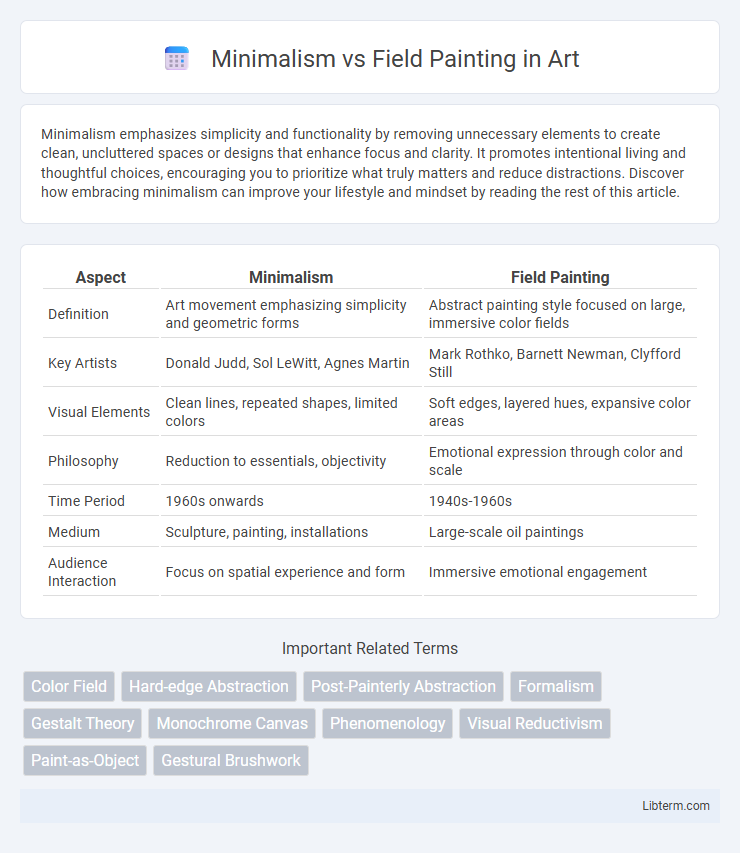Minimalism emphasizes simplicity and functionality by removing unnecessary elements to create clean, uncluttered spaces or designs that enhance focus and clarity. It promotes intentional living and thoughtful choices, encouraging you to prioritize what truly matters and reduce distractions. Discover how embracing minimalism can improve your lifestyle and mindset by reading the rest of this article.
Table of Comparison
| Aspect | Minimalism | Field Painting |
|---|---|---|
| Definition | Art movement emphasizing simplicity and geometric forms | Abstract painting style focused on large, immersive color fields |
| Key Artists | Donald Judd, Sol LeWitt, Agnes Martin | Mark Rothko, Barnett Newman, Clyfford Still |
| Visual Elements | Clean lines, repeated shapes, limited colors | Soft edges, layered hues, expansive color areas |
| Philosophy | Reduction to essentials, objectivity | Emotional expression through color and scale |
| Time Period | 1960s onwards | 1940s-1960s |
| Medium | Sculpture, painting, installations | Large-scale oil paintings |
| Audience Interaction | Focus on spatial experience and form | Immersive emotional engagement |
Introduction to Minimalism and Field Painting
Minimalism emerged in the 1960s as an art movement emphasizing simplicity, geometric forms, and a reduction of color and detail to focus on the essence of the subject. Field Painting, associated with post-war American artists, utilizes expansive color fields and abstract landscapes to evoke emotional and spatial depth without relying on traditional compositional structures. Both movements challenge traditional representation, with Minimalism prioritizing form and objectivity, while Field Painting explores atmospheric and immersive color experiences.
Historical Context and Origins
Minimalism emerged in the 1960s as a reaction against the emotional intensity of Abstract Expressionism, emphasizing simplicity, geometric forms, and industrial materials to reflect a new era of modernism. Field Painting, often linked to Color Field Painting, originated in the late 1940s and 1950s with artists like Mark Rothko and Barnett Newman, focusing on large areas of solid color to evoke emotional resonance and spiritual experience. Both movements share roots in post-war America but diverge in their visual strategies, with Minimalism favoring objectivity and detachment, while Field Painting prioritizes immersive color fields and subjective depth.
Key Philosophies and Principles
Minimalism emphasizes simplicity, reducing art to fundamental geometric forms and monochromatic palettes to evoke purity and objectivity. Field Painting, a subset of Color Field Painting, focuses on large expanses of color that create an immersive visual experience, highlighting emotion and spatial depth. Both movements reject traditional figurative representation but diverge as Minimalism values structural clarity while Field Painting prioritizes color's expressive potential.
Influential Artists in Minimalism
Minimalism, characterized by artists such as Donald Judd, Agnes Martin, and Frank Stella, emphasizes simplicity, geometric forms, and industrial materials, contrasting with the textured, organic brushwork of Field Painting exemplified by Helen Frankenthaler and Morris Louis. Judd's precise, modular sculptures and Martin's subtle grids illustrate Minimalism's reductionist approach, while Stella's shaped canvases challenge traditional painting formats. These influential artists shaped Minimalism as a movement focused on spatial clarity and neutral expression, diverging fundamentally from the expressive surfaces typical of Field Painting.
Notable Figures in Field Painting
Notable figures in Field Painting include Morris Louis, Kenneth Noland, and Helen Frankenthaler, who emphasized large-scale color fields to evoke emotional responses. These artists often employed staining techniques to create expansive, immersive canvases that contrasted the rigid geometry of Minimalism. Their work highlights the dynamic interplay between color, form, and space, distinguishing Field Painting within the Abstract Expressionist movement.
Visual Characteristics and Techniques
Minimalism emphasizes simplicity through geometric shapes, monochromatic palettes, and repetition, creating a sense of order and clarity using industrial materials and precise craftsmanship. Field Painting, exemplified by Color Field painters, utilizes expansive, flat areas of vibrant color to evoke emotional responses, often employing techniques like staining and layering of diluted pigments on large canvases. While Minimalism highlights structure and form, Field Painting focuses on the immersive experience of color and surface texture.
Color, Form, and Composition
Minimalism emphasizes simplicity through limited color palettes, geometric forms, and balanced compositions that reduce visual complexity to highlight purity and structure. Field Painting, often associated with Color Field artists, utilizes expansive, flat areas of vibrant color to evoke emotional resonance, prioritizing color intensity and large-scale forms over precise geometric structure. Both movements explore abstract visual language, but Minimalism favors clarity and form, while Field Painting immerses viewers in immersive color experiences.
Viewer Experience and Interpretation
Minimalism emphasizes simplicity and objective forms, encouraging viewers to engage with space, color, and materials without distraction, fostering a contemplative and direct sensory experience. Field Painting, part of Color Field art, immerses viewers in expansive areas of color, evoking emotional responses through subtle tonal variations and the interplay of hue and light. Both styles prioritize viewer interpretation, with Minimalism inviting analytical reflection and Field Painting prompting an intuitive, immersive emotional connection.
Impact on Contemporary Art
Minimalism revolutionized contemporary art with its emphasis on simplicity, geometric forms, and industrial materials, influencing design and architecture by challenging traditional representation and emotional expression. Field Painting expanded the boundaries of abstract art through large-scale, color-dense canvases that evoke emotional resonance and sensory experience, directly impacting color field painters and abstract expressionists. Together, these movements reshaped artistic priorities, shifting the focus toward perception, space, and viewer interaction in contemporary artistic practices.
Minimalism vs Field Painting: Key Differences and Similarities
Minimalism emphasizes simplicity, geometric forms, and industrial materials, aiming to reduce art to its essential components, while Field Painting focuses on expansive surfaces with nuanced color fields that evoke emotional responses. Both movements emerged in the mid-20th century and reject traditional figurative representation, prioritizing viewer perception and experience. Key differences include Minimalism's rigid structure versus Field Painting's fluid, immersive color environments.
Minimalism Infographic

 libterm.com
libterm.com